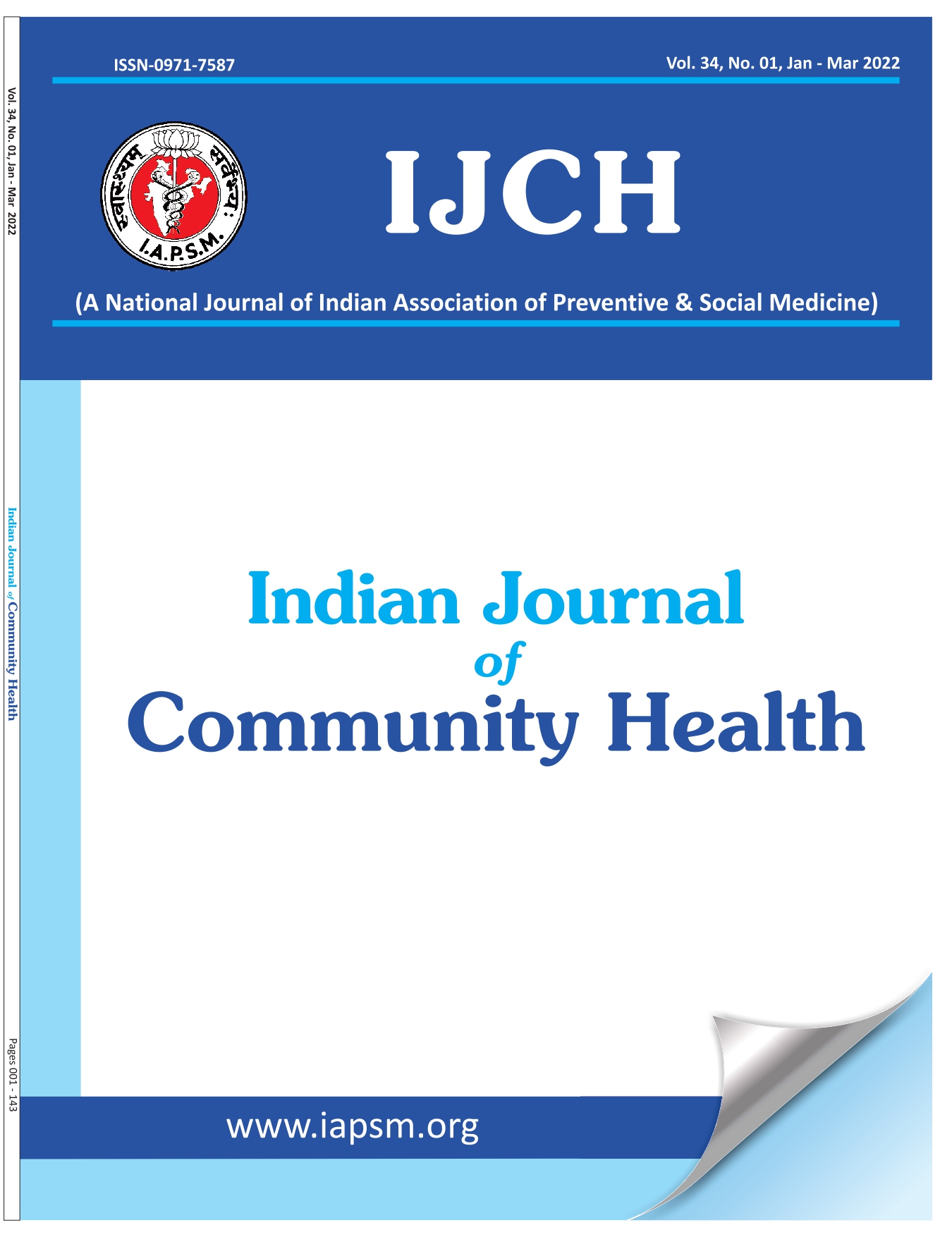Clinico-epidemiological study of safe and unsafe chronic suppurative otitis media
DOI:
https://doi.org/10.47203/IJCH.2022.v34i01.020Keywords:
Chronic Suppurative Otitis Media, Clinico-epidemiological, Safe, UnsafeAbstract
Introduction: Chronic Suppurative Otitis Media (CSOM) remains one of the most commonest chronic infectious diseases worldwide particularly in children and adolescents. India has been classified as the high prevalence country with national prevalence of 4%. Knowledge of differential regional prevalence of risk factors is required for adequate health education of masses and for customised preventive and control measures in respective areas. Aims: To study the clinical and socio-demographic profile of patients with CSOM. Methods: The study was carried out in the department of Otorhinolaryngology, Jawaharlal Nehru Medical College, AMU, Aligarh from November, 2017 to December, 2019. Patients with CSOM attending the otorhinolaryngology OPD and those admitted in IPD were included in the study. Results: A total 200 cases of chronic suppurative otitis media including both safe (mucosal) and unsafe (squamous) type were studied. The mean age of participants was 22.8 ± 15.18 years. Of the total participants, 111 (55.5%, 95% CI 48.6 to 62.2) were males, 89 (44.5%, 95% CI 37.8 to 51.4) were females and the majority (60.5%, 95% CI 53.6 to 67) of them were from rural background. Around one-fourth of the patients were illiterate (23%, 95% CI 17.7 to 29.3) and the patients mostly belonged to lower side (lower middle, upper lower and lower) of the spectrum of Kuppuswamy socioeconomic classification. The distribution of age-group, gender and laterality (side of involvement) was similar (P>0.05) in both safe and unsafe type. Overall, 151(75.5%, 95% CI 69.9 to 80.9) patients were found to have conductive hearing loss, 30 (15%, 95% CI 10.7 to 20.6) with mixed and 19 (9.5%, 95% CI 6.2 to 14.4) did not have any hearing loss at presentation. The distribution of patients with regards to hearing loss was found to be similar in both safe and unsafe groups (P = 0.311). Conclusion: CSOM particularly afflicts younger age populations from rural background with poor socioeconomic status. Appropriate timely interventions in the form of health promotion, education about the risk factors and improvement in the living conditions will result in decrease in incidence and prevalence of the disease. Moreover, knowledge of symptoms and signs of the disease is likely to result in early seeking of healthcare and hence better treatment outcomes and prevention of complications.
Downloads
References
WHO/CIBA Foundation Workshop. Prevention of Hearing Impairment from Chronic Otitis Media. CIBA Foundation, London, UK; 1996. Available from?: http://WHO_PDH_98.4.pdf [Accessed on 18/03/22]
Monasta L. et al. Burden of disease caused by otitis media: systematic review and global estimates. PLoS ONE 7, e36226 (2012).
https://doi.org/10.1371/journal.pone.0036226
World Health Organization. Chronic Suppurative Otitis Media: burden of illness and management options. WHO 2004. Geneva
Verhoeff M, van der Veen EL, Rovers MM, Sanders EA, Schilder AG. Chronic suppurative otitis media: a review. Int J Pediatr Otorhinolaryngol. 2006 Jan;70(1):1-12. doi: 10.1016/j.ijporl.2005.08.021. Epub 2005 Sep 27. PMID: 16198004.
https://doi.org/10.1016/j.ijporl.2005.08.021
Raushan EA, Kumar J, Kapoor S, Pathak SD. Clinico-Epidemiological Profile of Tubotympanic Type of CSOM. Annals of International Medical and Dental Research;2016;2(6):16-19.
https://doi.org/10.21276/aimdr.2016.2.6.en5
Rupa V, Jacob A, Joseph A. Chronic suppurative ofitis media: prevalence and practices among rural South Indian children. Int J Pediatr Otorhinolaryngol. 1999: 48(3):217-21.
https://doi.org/10.1016/s0165-5876(99)00034-8
Vikram BK, Khaja N, Udayashankar SG, Venkatesha BK, Manjunath D. Clinico-epidemiological study of complicated and uncomplicated chronic suppurativc otitis media. J Laryngol Otol. 2008; 122:442-6.
https://doi.org/10.1017/s0022215107000278
Chronic suppurative otitis media: Burden of Illness and management options; Child and Adolescent Health and Development Prevention of Blindness and Deafness, WHO report. Geneva. 2004:17-8.
Parvez A, Khan Z, Hashmi SF, Khan MS. A cross sectional study of chronic suppurative otitis media and its associated factors among primary school children in rural and urban areas of Aligarh, India. Int J Community Med Public Health. 2016 Aug;3(8):2150-4.
https://doi.org/10.18203/2394-6040.ijcmph20162561
Dutton DB. Socioeconomic status and chidren’s health. MedCare. 1985; 23(2): 142-56.
Tiwari R, Samant H, Verma D. A ckinicoradiological study of cholesteatoma. Ind J Otolaryngol Head Neck Surgery 1991; 43 (3):130-5
Bandyopadhyay R, Sengupta A, Dassupta A, Biswas R, Mukherjeen S, Biswas AB. A comparitive study of common ear morbidity pattern among the primary school children of an urban slum of Kolkata and rural area of Hooghly. J Ind Med Assoc. 2005; 103 (8):428-32.
Saleem SM, Modified Kuppuswamy socioeconomic scale updated for the year 2020. Indian J Forensic Community Med.2020;7(1):1-3
https://doi.org/10.18231/j.ijfcm.2020.001
Sengupta Arunbha, Anwar Tarique, Ghosh Debasish, Basak Bijan. A study of surgical management of chronic suppurative otitis media with cholesteatoma and its outcome. Indian J Otolaryngol Head Neck Surg. 2010;62(2):171–76. DOI:10.1007/s12070-010-0043-3.
https://doi.org/10.1007/s12070-010-0043-3
Basak B, Gayen GC, Das M, Dhar G, Ray R, Das AK. Demographic profile of CSOM in a rural tertiary care hospital. IOSR J Pharm. 2014;4(6):43-6.
https://doi.org/10.9790/3013-040601043046
Shetty S. Pre-operative and post-operative assessment of hearing following tympanoplasty. Indian Journal of Otolaryngology and Head & Neck Surgery. 2012;64(4):377-81.
https://doi.org/10.1007/s12070-011-0331-6
Tshering P, Joarder MA, Chowdhury MA, Saha KL. Clinicopathological study on CSOM: a comparison between tubotympanic and atticoantral variety. Bangladesh Journal of Otorhinolaryngology. 2012;18(2):138-44.
https://doi.org/10.3329/bjo.v18i2.11991
Shrestha BL, Shrestha I, Amatya RC. Comparison of clinical presentation between Chronic Otitis Media Mucosal with Squamous. Kathmandu University Medical Journal. 2010;8(4):387-91.
https://doi.org/10.3126/kumj.v8i4.6237
Rehman HR, Wahid FI, Khan N, Khan A, Khan MR and Shahabi IK. Attico-Antral vs. Tubo-Tympanic Chronic Suppurative Otitis Media. Journal of Rawalpindi Medical College (JRMC); 2014;18(2):257-259 25.
Islam MR, Taous A, Hossain MM, Ekramuddaula AFM and Islam MS. Comparative study of tutotympanic and atticoantral variety of chronic suppurative otits media. Bangladesh J Otorhinolaryngol 2010;16;113-9.
https://doi.org/10.3329/bjo.v16i2.6846
Gulati SP. , Sachdeva OP and Kumar P, Audiological profile in chronic suppurative otitis media, Indian Journal of Otology.2002;8(1): 24–28
Downloads
Published
How to Cite
License
Copyright (c) 2022 Indian Journal of Community Health

This work is licensed under a Creative Commons Attribution-NonCommercial-NoDerivatives 4.0 International License.





